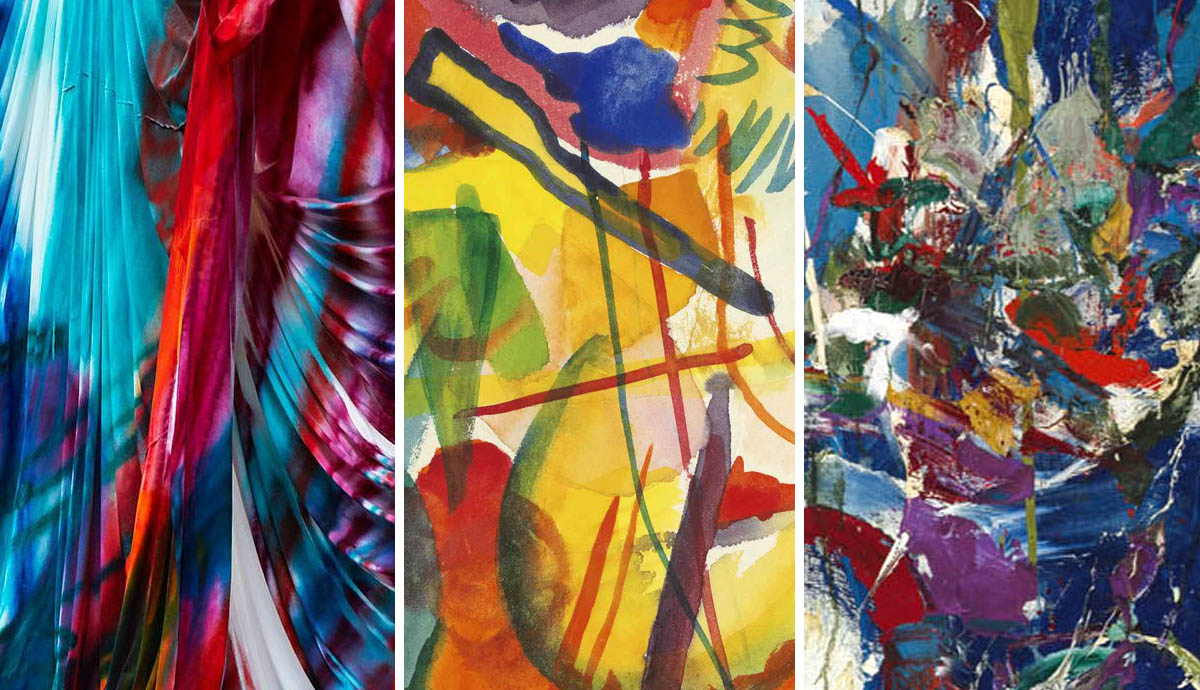
Abstract art makes no reference to the real world, instead drawing attention to its status as an art object – “art for art’s sake”, as some might say. But it can take a huge variety of forms, from sculpture to photography, drawing and installation. It can also be made in an enormous range of styles, from wild, expressive paint to clean geometric shapes and lines. If in doubt, ask yourself: can I see anything real in this artwork? If not, chances are, it’s probably abstract.
Early Abstract Art

Some of the earliest examples of abstract art date from the beginning of the 20th century. The invention of photography changed the role of art, freeing it from the confines of representation to become something entirely new. Artists across Europe, the United States and beyond experimented freely with the nature of art during this time, and several pioneers created the very first abstract works of art.
Russian Abstraction

Russian artist Wassily Kandinsky is often referred to as “the father of abstract art.” He coined his painting Composition V, 1911 “the world’s first ever abstract picture,” for its swirling lines, dazzling colours and kaleidoscopic movement, although some have suggested there are still allusions to the landscape within this work. After creating this work, he went on to pioneer a purer form of abstraction based on the sonorous qualities of line, shape and colour. Russian Constructivist Kasimir Malevich is also heralded as one of the first truly abstract painters. His radical and subversive Black Square, 1915, made a complete break with the real world, stripping the nature of art to its most elemental basics. Featuring a painted black square on a painted white ground, Malevich saw this painting as the beginning of a new era in art, when art would become entirely self-referential and self-sustaining. And in a way, he was right.
Piet Mondrian’s Abstraction

Another pioneer in simple abstraction was the radical Dutch artist Piet Mondrian, who, like Malevich, saw abstraction as a stripping back process, reducing the nature of art to its fundamental elements of simplicity: straight lines, primary colours, black and white. As his career progressed, he used these building blocks in the most playful and experimental ways, as demonstrated in his masterful Composition with Yellow, Blue and Red, 1937-42.
Expressive Abstraction

In the 1950s a band of American artists now known as the Abstract Expressionists redefined the nature of abstract art. Leaders of the style were Jackson Pollock, Willem de Kooning, Lee Krasner, Helen Frankenthaler and Joan Mitchell. They created epic, enormous canvases filled with gestural applications of paint, from swooping loops of household gloss to great stains of diluted acrylic. More than ever, these artists made art all about the process of making.
Minimalist Abstraction

Throughout the 1960s and beyond various artists across Europe and the United States invented a new style of abstract art now known as Minimalism. It was all about clean lines, pale colours and geometric designs, stripping art back to its basic components to create space for calm, spiritual contemplation. Abstraction appeared in sculptures during this time, such as American sculptor Donald Judd’s wall mounted metallic creations and American artist Sol LeWitt’s pared back wooden constructions. Drawing was popular among various Minimalist artists such as American artist Agnes Martin, who made huge grids featuring hand-drawn pencil lines in a series of repetitive grids.
Abstract Art Today

Abstract art continues to be a popular style of art for so many of today’s most successful artists. Some focus on the process of making, such as Scottish artist Callum Innes, who describes his process of pouring turpentine onto canvases loaded with thick paint as “un-painting.” Others are free and expressive, expanding out into whole rooms with streaks and swathes of colour, as seen in the monumental art of Katharina Grosse, who covers walls, ceilings, windows and floors with unstoppable mounds of luminescent colour.







